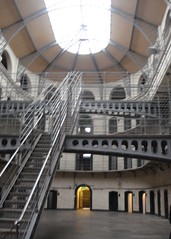 One reason I am as dedicated to this blog as I am is that I am from New Orleans. Since last Thursday we have had 197 murders here so far this year alone — last year’s tally was 175 or 51 murders per 100,000 residents. That’s 10 times the national average. Most of them committed by our inner city youth.
One reason I am as dedicated to this blog as I am is that I am from New Orleans. Since last Thursday we have had 197 murders here so far this year alone — last year’s tally was 175 or 51 murders per 100,000 residents. That’s 10 times the national average. Most of them committed by our inner city youth.
Crime here has always been extreme, but since Hurricane Katrina and the levee failures that followed it things have gotten so much worse. The real tragedy is that often both the victims and the perpetrators of these killings are the city’s youth. Poverty, low quality education, and many other factors have been entrenched here for close to 300 years, but there has been an added array of issues added to the mix in the post storm era.
USA Today‘s Rick Jervis takes a look:
Why has it been so difficult to staunch the killings, even with new leadership at the police department and the conviction of several officers involved in post-Katrina shootings of civilians? Katrina and the ensuing collapse of schools, home life and other support structures likely played a role, says Lance Hill, executive director of the New Orleans-based Southern Institute for Education and Research, who has tracked crime trends.
Children displaced by the floods returned with their families to a wrecked city, bounced from school to school and lacked mental health professionals to help them through the trauma, he says.
Six years later, many of those kids are under-educated, unemployed and seeping into trouble, Hill says. School expulsion rates also soared after Katrina, putting more kids on the street, he says.
‘The spike in violence we’re seeing …was in fact predicted by experts,’ Hill says. ‘Their warnings went unheeded.’
It is because of the Humane Exposures approach of rehabilitation and addressing the root causes of crime that I consider this blog important. All I have to do is look at the current local debate about whether to call in the National Guard because of the shootings to see the the results of neglecting these sources of anomie.
Over our first year back in New Orleans in the wake of the disaster my wife often commented on the fact that we had become a city without elders. Since grandparents are a culturally vital part of ours of any other community you can see the problem. Additionally, once tightly knit family groups were scattered to the four winds, with many financially unable to effect a return even unto this day. While poor parenting skills are certainly a factor here, in many cases the parents have not returned to the city, but the kids have. In the meantime mental health resources have progressed from nonexistent to marginal over the years, and are not easily accessible for adults or children.
Education, mental health care, and substance abuse programs are all vital and effective alternatives to incarceration. They are also a good vaccination against the behaviors that lead to it. Right now New Orleans is buried in a crime wave spawned by a lack of all of these factors.
If you need a good argument a to why these tactics should be embraced just take a look at our murder rate here in the Crescent City. By the time you read this it may have passed the 200 mark.
Image Source: Loki, used by permission



 The economic side of the penal system is something we look at a lot. In so many cases, the return of preventative programs vastly outstrips the return we see from imprisoning people. Our documentary is titled
The economic side of the penal system is something we look at a lot. In so many cases, the return of preventative programs vastly outstrips the return we see from imprisoning people. Our documentary is titled  It is no secret that there is a link between education and one’s eventual path in life. Nowhere is this more painfully asserted than by the number of dropouts that end up in jail or prison. In Alabama, the officials have taken notice, and are using a short documentary film to communicate the “stay in school and out of prison” message to the students. Rick Harmon, a reporter for
It is no secret that there is a link between education and one’s eventual path in life. Nowhere is this more painfully asserted than by the number of dropouts that end up in jail or prison. In Alabama, the officials have taken notice, and are using a short documentary film to communicate the “stay in school and out of prison” message to the students. Rick Harmon, a reporter for  A report card that examines the treatment of mothers and pregnant women in prison has been issued recently, and several states are none too happy about the grades they’ve received. (California scored a cumulative “C-” in case you are curious.)
A report card that examines the treatment of mothers and pregnant women in prison has been issued recently, and several states are none too happy about the grades they’ve received. (California scored a cumulative “C-” in case you are curious.) Judge Michael Tynan’s fourth-floor courtroom in downtown L.A.’s Criminal Courts building is in our spotlight today. It’s a room that’s usually packed with people that are often discarded by society: the addicts, the mentally ill or disadvantaged, the homeless, and, more recently, the female parolees.
Judge Michael Tynan’s fourth-floor courtroom in downtown L.A.’s Criminal Courts building is in our spotlight today. It’s a room that’s usually packed with people that are often discarded by society: the addicts, the mentally ill or disadvantaged, the homeless, and, more recently, the female parolees. Interesting things are happening in the California penal system. Both sides of the aisle, left and right, have plans for a big change in the way the prison system works. Of course, much of this is being fueled by the massive deficit facing the state.
Interesting things are happening in the California penal system. Both sides of the aisle, left and right, have plans for a big change in the way the prison system works. Of course, much of this is being fueled by the massive deficit facing the state. One of the persistent issues in the American penal system is that it is massively overcrowded. A plethora of reasons for this abounds, as a simple Google search will show. The solutions have been in shorter supply.
One of the persistent issues in the American penal system is that it is massively overcrowded. A plethora of reasons for this abounds, as a simple Google search will show. The solutions have been in shorter supply.







